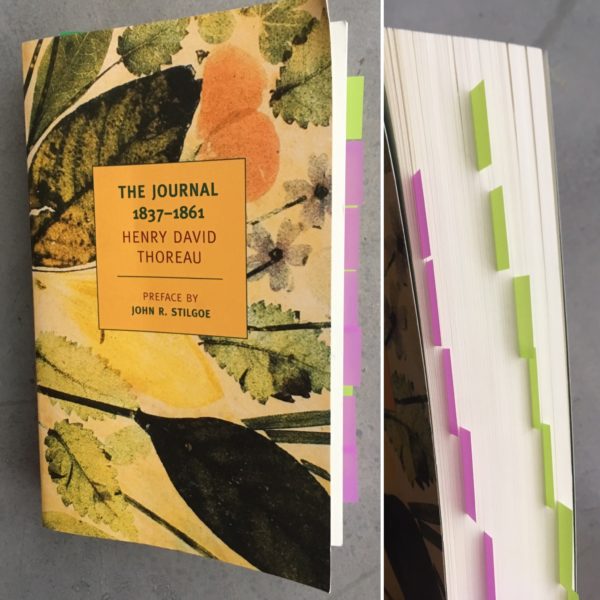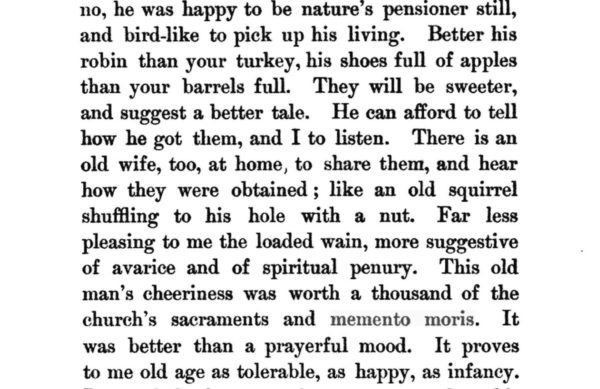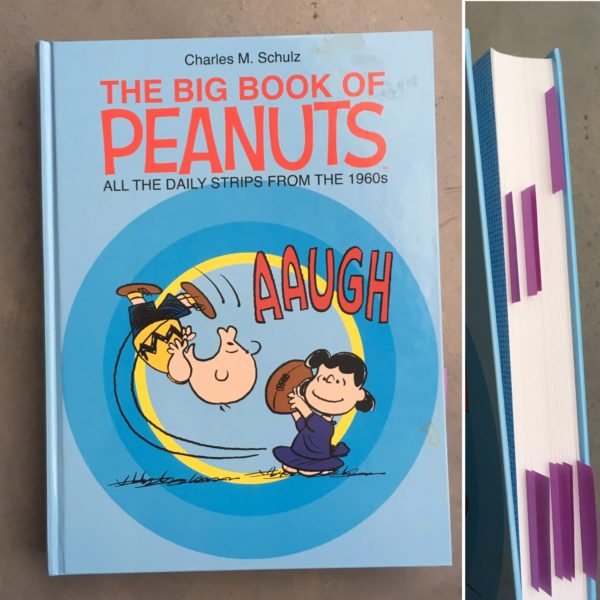
I bought this handsome NYRB edition of Thoreau’s journal a few months ago when I saw that John Stilgoe had written the preface. (I took it as a BUY NOW sign: I’d read his book Outside Lies Magic earlier this year liked it quite a bit.)
It’s a highly edited and condensed version of the complete 47 volumes of Thoreau’s output, but I still wasn’t sure how to read the thing. I couldn’t imagine actually reading it front to back. Then I noticed that the left-hand page headers refer to the approximate date, but the right-hand page headers refer to what age Thoreau was when he wrote the entry. This seemed like a fun game: Let me see what Thoreau was writing when he was exactly my age.
Then I thought it’d be fun to just follow along with his life day-by-day and year-by-year, almost like turning The Journal into one of those 5 year diaries that you see in stationery stores. I’d stick post-it notes on the current date of each year of the journal, then check the tabs each day to see if there’s an entry.
This turns out to be a terrific way to read Thoreau, because he was so obsessed with observing nature and the changing seasons. You see, for example, how Thoreau repeats himself, noting the fallen leaves in October. (“How beautifully they go to their graves!”)
Yesterday, I read the entry for October 20, 1857, exactly 160 years ago, in which Thoreau writes beautifully about meeting a barefoot old man carrying a dead robin & his shoes full of apples:

I got such a kick out of reading this way I wondered what other books I had lying around the house that I could turn into a daily devotional. How about my Big Book of Peanuts?
I mean, of course a collection of daily newspaper strips, originally written to be consumed on one particular day, makes for good daily reading. (Think of all the “Page-A-Day” Peanuts calendars.) But there’s another reason they’re so great to read day-by-day: Peanuts function as a sort of coded diary for Schulz. This is explained by Bruce Eric Kaplan in the introduction to his collection, This Is A Bad Time:
[T]hese drawings are really my journals. I use them to explore whatever I find interesting, confusing, or upsetting on any given day. But here’s the beauty part—these private thoughts are filtered through the prism of moody children and blasé pets, disillusioned middle-aged men and weary matrons, among others. And so I get to work through whatever I am thinking about in a coded way. No one but me will ever know what the real seed of each image and caption was. So I can be free as I want to say whatever I want, and no one can catch me. It’s great….Every morning… I sit down and think about why I am disgruntled or why I am not as disgruntled as I was yesterday and out come these little drawings…
This connection between daily comic strips and diaries is made more explicit in the work of someone like James Kochalka in his sketchbook diaries, American Elf. I have all 14 years on my iPad now, so it wouldn’t be hard to read them in the same way I do the Peanuts collection. Strangely, I find that having a digital collection of the strips makes me want to reorganize the entries in non-chronological ways, like, reading every strip that includes leaves or clouds.
I have an ebook of Andy Warhol’s diary, and I like to search it whenever I’m in a spot that I know he had some connection to. (When I was in Milan, I typed in “Milan,” and landed on his entry for Monday, September 17, 1979, which contains the question, “Why would anybody want to go to Milan?”)
Anyways, I’m wandering towards a point: To read collected works is to also grapple with the question of how (or when!) to read collected works.
This, by the way, is the end of the Peanuts strip published on Oct. 20, 1962, 56 years ago:

Sound like someone you know?
